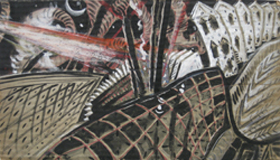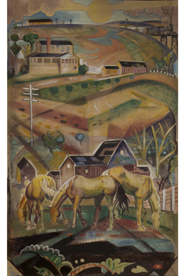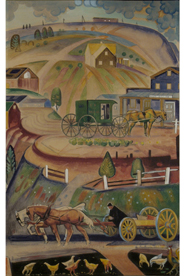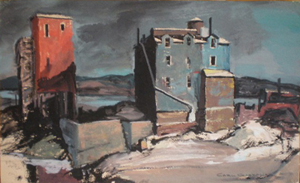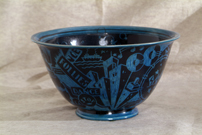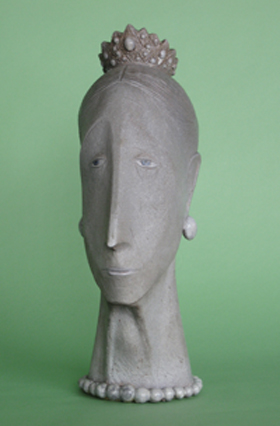From the Encyclopedia of Cleveland History
ART. The development of an art life in Cleveland primarily resulted from the efforts of 2 distinctly different groups within the community: the wealthy patrons of art and the artists themselves. The first group consisted of families who accumulated their wealth from industry and commerce; the artists derived mainly from the German community. Also important was the influence of the commercial arts on other aspects of Cleveland’s art life. These contributing factors would change–to varying degrees–following World War II. An established art life really did not begin in Cleveland until 1876. In earlier years the city managed to support a few itinerant portrait painters, woodcarvers, stonecutters, and sign painters. Traveling exhibitions were occasionally announced in the newspapers and were usually held in the courthouse or local churches. Typical of these was an exhibition in 1844 that featured reproductions of Italian and Flemish paintings. By 1857 the Cleveland directory listed 6 professional artists. They mainly subsisted on portrait commissions and fees for individual or class instruction. Painting was occasionally lucrative, as in the case of JULIUS GOLLMAN†, who received $400 for his group portrait of the Arkites. In 1876 2 events combined to accelerate the growth of art in Cleveland. The Centennial Exhibition in Philadelphia, with its various displays of European and American art, is largely credited with encouraging local art interest throughout America. The most popular painting at the exhibition was SPIRIT OF `76 by Cleveland painter ARCHIBALD WILLARD†, who returned to Cleveland a celebrity and agreed to lead a group of young artists who that year formed the Cleveland ART CLUB. Also known as the Old Bohemians, the artists obtained rent-free space on the top floor of the Case Block (the city hall annex), where they set up studios and offered classes. The Cleveland Art Club provided the city with its first nucleus of notable artists, most of them–such asFREDERICK GOTTWALD†, OTTO BACHER†, and Max Bohm–the sons of German immigrants. Many received training abroad, primarily at the art schools in Munich and Dusseldorf.
In 1878 a group of women organized the first loan exhibition in Cleveland (see ART LOAN EXHIBITIONS) in order to raise money for social relief. The exhibition featured 167 oils, 67 watercolors, books and manuscripts, ceramics, bronze and statuary, gems, laces, and an Oriental collection. As in future loan exhibitions, artwork was borrowed from private collections in Cleveland, as well as from other cities. Many of the city’s galleries and art stores mainly offered for sale reproductions of European paintings. Sales of original works by the old masters increased toward the end of the century. Although a few galleries set aside space for local artists, their works were seldom sold. Oscar Wilde’s lecture in Cleveland in 1882 on the English Arts & Crafts Movement helped to encourage the founding later that year of the Western Reserve School of Design for Women (the future Cleveland School of Art). Art activity continued to increase in the 1890s with the founding of several new artists’ and art organizations, and 2 more loan exhibitions, in 1893 and 1894. The catalog for the loan exhibition in 1893 reveals the steady growth of art in private homes in Cleveland since the first loan exhibition 15 years earlier. The Cleveland Art Assn., the first organized effort among the city’s wealthy industrialists to promote art in Cleveland, was responsible for the loan exhibition in 1894. As the year before, half the proceeds were donated to the city’s poor fund, and the other half for the purchase of artwork for a future museum.
In the first decade of the 20th century, Cleveland experienced a lull in its art development. One reason was the defection of many of the city’s finest artists to Europe in search of a more favorable art climate. This emigration led in part to the dissolution of the Cleveland Art Club, the city’s most vital artists’ organization. Another factor for this period of inactivity was the delay in the establishment of an art museum. By 1891 3 substantial funds had been bequeathed for this purpose, but problems arose from an inability to legally consolidate the separate trusts. Late in arriving (even Toledo had an art museum before Cleveland), the CLEVELAND MUSEUM OF ART was finally incorporated in 1913. In the meanwhile, exhibitions were periodically held at CHAS. OLNEY’s private gallery and the Cleveland School of Art’s new building (1906), which featured the city’s first large exhibition room. From 1910-29, the city experienced its greatest period of art activity, reflected in the emergence of the Art Museum, the MAY SHOW, a resurgence in art and artists’ organizations, and a number of exhibitions of current art from Europe. In 1913 10 cubist works from Paris were exhibited at the Taylor Dept. Store and caused quite a negative reaction in the community. The following year a Cleveland expatriate artist, ALEXANDER WARSHAWSKY†, organized an exhibition of postimpressionist paintings that included the works of fellow Cleveland artists. This show also drew almost unanimous criticism, the PLAIN DEALER labeling it as the “Biggest Laugh in Town.” Although the city wished to eliminate its provincial image, as late as the 1930s paintings of “undraped nudes” would still excite controversy in the newspapers.
The 1910s also saw the emergence of 2 dominant artists’ organizations in the city. The CLEVELAND SOCIETY OF ARTISTS was founded in 1913 as a revival of the Cleveland Art Club. Its initial purpose was to continue the tradition of academic art. Its antithesis was the KOKOON ARTS CLUB, founded in 1911. Cofounder CARL MOELLMAN† oriented the club toward the philosophy of his New York mentor, Robt. Henri, who disdained academicism in favor of more individualism in art. Cleveland at this time was becoming a thriving commercial-arts center. In lithography, the Morgan and Otis companies, and later Continental, were attracting artistic talent from around the country. The city also boasted well-known engraving and publishing houses such as the Caxton Co. In ceramics, the Cowan Pottery in ROCKY RIVER was gaining national recognition, in large degree due to the “Jazz Punch Bowl” designed for it by Viktor Schreckengost, an instructor at the Cleveland School of Art. The artists’ organizations drew the bulk of their membership from the commercial arts, providing artists with an uncensored outlet for their creative energies. The Kokoon Club was significant in that it provoked a struggle for the city to achieve a reconciliation between progress and extremism. This struggle was based largely on a misconception among Americans that linked “new art” to political extremism and immoral behavior. Tension increased with city hall when the Kokoon Club’s annual ball began to display some of the antisocial themes pervasive among America’s avant-garde following World War I. Mayor FRED KOHLER† banned the ball in 1923, claiming that the event fell within Lent, but it was resumed the next year and continued to attract enormous publicity (from outside the city, as well) as the yearly review of Cleveland’s Latin Quarter.
This second generation of Cleveland artists still consisted largely of the sons and grandsons of German immigrants (of the 13 original members of the Kokoon Club, 9 were of German heritage). Many still received training in Germany, although the French postimpressionists–especially Cezanne
–were also popularly emulated. Because many of the city’s artists made a living as engravers, illustrators, and lithographers, fine draftsmanship often characterized their efforts–as in the paintings of WM. SOMMER†. Overall, like most American artists until World War II, Cleveland artists generally sought a middle-of-the-road compromise between the old masters and moderns. The introduction of the MAY SHOW in 1919 helped considerably to bring attention to local artists. The Cleveland Museum of Art and the new Cleveland Art Assn. (revived 1915) organized the first May Show to exhibit the works of local artists and craftsmen and to provide a market for their sale. A similar show already existed in Chicago, but the Cleveland show was to become one of the country’s largest and best known. Traveling exhibits were sent around the country and did much to establish the reputation of Cleveland as an art center.
As the new center of art in Cleveland, the Art Museum implemented many programs to promote art in the city. For the general public, various educational programs were offered. In 1918 the museum stated an intention to build permanent collections in areas that would benefit the city’s industries, such as printing, textiles, iron and steel, furniture, and woodcarving. That resulted in the founding of the PRINT CLUB OF CLEVELAND in 1919, and the Textile Art Club in 1934. In the 1920s, Cleveland surpassed Boston as the country’s leading center in watercolor painting. The medium achieved popularity here because of the close-knit character of the artistic community; moreover, from 1924 it was the most important feature of the May Show. Many of these paintings won prizes at the prestigious Annual Intl. Exhibition at the Carnegie Institute in Pittsburgh. Such attention helped to bring about the identification of a “Cleveland School” of artists, which, besides Sommer, included Alexander and Abel Warshawsky, GEO. ADOMEIT†, HENRY KELLER†, PAUL TRAVIS†, FRANK WILCOX†, CHAS. E. BURCHFIELD†, and many others whose work gained notable attention outside Cleveland. Despite growing recognition, the artists received a great unevenness of support in Cleveland itself. The May Show, ironically, was partly responsible. Removed from the show’s prestige, the artists were more or less left stranded the remainder of the year. The various artists’ organizations offered comparable works at yearly auctions, but these usually sold at disappointingly low prices. Dwelling in the shadow of the May Show, in later years such exhibitions indeed became popularly known as “reject shows.” The wealthy in Cleveland were primarily dedicated to the collection of European art, and patronage of the Art Museum and May Show.
Like everything else, art in Cleveland suffered during the Depression. For the Cleveland Museum of Art, bequests were reduced, and purchases had to be curtailed. At the Cleveland School of Art, enrollment dropped 35% between 1930-33. Many artists and craftsmen dependent on the commercial arts for a living applied to the WPA’s Federal Art Project, which had been prefigured by the Public Works of Art Project, established in 1933. Under the PWAP, Cleveland artists produced 8 murals for the CLEVELAND PUBLIC LIBRARY, plaques for schools, historical maps, and other art objects. Later, in 1936, the FAP put 75 Cleveland artists to work in an old factory building to make signs, lantern slides, paintings, and sculptures. Ceramics were also produced and were very much in demand throughout the country, upholding Cleveland’s national reputation in that area of art production. Notable were the figurines of storybook characters produced by Edris Eckhardt and others for the CPL. By the late 1930s, there was a general decline among Cleveland’s artists’ organizations. The Depression and the increasing use of automation in th e commercial arts, especially lithography, helped to check the flow of artists into Cleveland. European-trained artists were aging and giving way to a greater diversity of younger artists from the highly regarded Cleveland School of Art. As “new art” became more acceptable, the Kokoon Club and Cleveland Society of Artists blurred together. For these reasons, and others that occurred after the war, Cleveland’s artists’ organizations would never again be as visibly active.
In the late 1930s and early 1940s, the art center of the world moved from Paris to New York, which also marked a turning point in the art life of Cleveland. After the war, a general shift took place in Cleveland from smaller commercial-art companies mainly involved in graphic arts (lithography, engraving, advertising, etc.) to a diversity of larger companies interested in industrial design. From the 1920s, the Cleveland School of Art had been placing a stronger emphasis on the practical uses of art and design in order better to serve the various industries in Cleveland. Following the war, this emphasis increased as manufacturing companies across America called for advertising artists and industrial designers to work in such industries as automobiles, home appliances, aluminumware, toys, ceramics, and greeting cards. Previously, most of Cleveland’s artists had been concentrated in several leading commercial art firms; now there was a general dispersion of artists, craftsmen, and designers among many industries. There was also the new and overpowering draw of New York for younger artists. These factors contributed to a further debilitation of the artists’ organizations and led to a continuing shift in focus from local to regional art.
As the importance of the artists’ organizations diminished, the void would be filled in the 1950s with a proliferation of neighborhood art centers and a multitude of art events sponsored by such diverse organizations as women’s clubs, churches, cultural institutions, civic and ethnic groups, and department stores. In 1949 the CLEVELAND INSTITUTE OF ART Alumni Assn. held its first annual art show and sale at SHAKER SQUARE. It was followed in the 1950s by a strong involvement from the Jewish community with the introduction of the JEWISH COMMUNITY CENTER show. The annual exhibition at the PARK SYNAGOGUE, begun in 1960, helped to bring local attention to new movements in modern art, such as abstract expressionism. Black artists in Cleveland were also making an important contribution. In 1940 6 black artists, under the auspices of the KARAMU HOUSE, formed a new artists’ organization known as the Karamu artists. Within a few years they developed into the largest single group of black artists in the country, exhibiting at such notable institutions as the Cleveland Museum of Art and the Pennsylvania Academy of Fine Art. The Karamu House has also, since 1915, maintained a gallery with special interest in the works of talented black artists.
By the early 1960s, the diversity of local involvement had become considerable. In 1964 local exhibitions included, among others, African art at the May Co., master prints at Higbee’s, the Baycrafters’ annual juried show, an exhibition of Cleveland artists at the Circle Gallery, the annual exhibition of work by teachers of art in Cleveland high schools, and a show by students of the Cooper School of Art. Gallery openings and closings also proliferated at this time. The HOWARD WISE GALLERY OF PRESENT DAY PAINTING, opened in 1957, attempted with little success to bring works of contemporary European and American artists to Cleveland, and in 1961 moved to New York. In contrast to New York, where galleries are concentrated in specific parts of the city, galleries in Cleveland since the war have been dispersed throughout the greater metropolitan area. Recently, however, artists and galleries have been attracted to the Murray Hill area and later to TREMONT. In the 1970s, a number of outdoor art fairs were introduced in Cleveland. Included among these were the Boston Mills, Lakewood, Cain Park, and Clifton art festivals. Since the 1950s, corporations have arrived on the local art scene in an area formerly dominated by the wealthy industrialists. They have joined local foundations in making grants to art institutions in Cleveland; many corporate executives serve as board members for these institutions. Although its arrival was somewhat late in Cleveland, corporate art collecting has been a significant factor in the city’s art life since 1975.
In addition to its other exhibits, the Cleveland Museum of Art has customarily put together at least 1 major exhibit yearly. One of its best-known shows nationally was a bicentennial exhibition, “EUROPEAN VISION OF AMERICA,” which it cosponsored with the Natl. Gallery and the French government. A nearly $2 million deficit in 1992, however, led to the elimination of the museum’s popular Extensions Exhibition Service, which had provided exhibits for such venues as the Beck Ctr. for the Cultural Arts and the Cleveland Public Library. In 1976 Clevelanders were forced to confront modern sculpture in Isamu Noguchi’s The Portal. Commissioned by the GUND FOUNDATION at a cost of $100,000, the 15-ton, 36′ high curving configuration of carbon steel piping is located at the W. 3rd St. entrance of the Justice Ctr. Sherman Lee, then director of the Cleveland Museum of Art, considered The Portal one of the most important monumental sculptures in the U.S. Public reaction–especially to its cost/value–was mostly opposite. Later, when BP America declined to install a giant rubber hand stamp entitled Free Stamp, which it had commissioned from sculptor Claes Oldenburg for its headquarters on PUBLIC SQUARE, the city found a place for it in Willard Park.
In recent years Cleveland has seen the founding of several theme-based nonprofit art organizations. Contemporary art finally gained a foothold in the city with the establishment of the CLEVELAND CENTER FOR CONTEMPORARY ART in 1968. A similarly oriented organization is the Spaces Gallery, located in the warehouse district. Both organizations claim a commitment to Ohio artists. A revived interest in the “Cleveland School” artists led, in 1984, to the founding of the CLEVELAND ARTISTS FOUNDATION, which by 1993 had acquired a collection of 300 works in its area of interest. NOVA (the New Organization for the Visual Arts) is dedicated to the advocation of the artist in the community, a responsibility previously held by the now-defunct Cleveland Area Arts Council. NOVA has implemented many new programs and exhibitions, including, in 1983, the Art in Special Places Program to expose art to people who do not frequent museums and galleries.
Compared to cities with similar growth, an art life in Cleveland was late to arrive. But between 1910-29, Cleveland experienced a renaissance in art that rivaled, and in some areas surpassed, that of other cities in America. The viability of the commercial arts in the city and the leadership of the Art Museum were strong contributing factors. With the possible exception of the May Show, Cleveland’s art life has not been innovative, but rather has reacted to outside influences. Since World War II, Cleveland, like all other American cities, in terms of art has largely dwelt in the shadow of New York. The Cleveland Museum of Art, of course, has been a leader in such areas as Oriental art. Both the Art Museum and the Cleveland Institute of Art are proudly supported and remain among the finest of their kind in the country. But there is, perhaps, a tendency among Clevelanders to see these two institutions as the only centers for art in the city. That has led to Clevelanders’ not fully taking advantage of the manifold offerings of the city’s art life and, perhaps more seriously, has made it sometimes difficult for galleries, artists, and smaller art organizations to achieve a vital existence in the city.
James Shelley
Clark, Edna. Ohio Art and Artists (1932).
Marling, Karal Ann. Federal Art in Cleveland, Cleveland Public Library (1974).
Smart, Jermayne. “Folk Art of the Western Reserve” (Ph.D. diss., WRU, 1939).
Witchey, Holly Rarick. Fine Arts in Cleveland: An Illustrated History (1994).
Wittke, Carl. The Cleveland Museum of Art (1966).
Wixom, Nancy Coe. Cleveland Institute of Art (1983).

